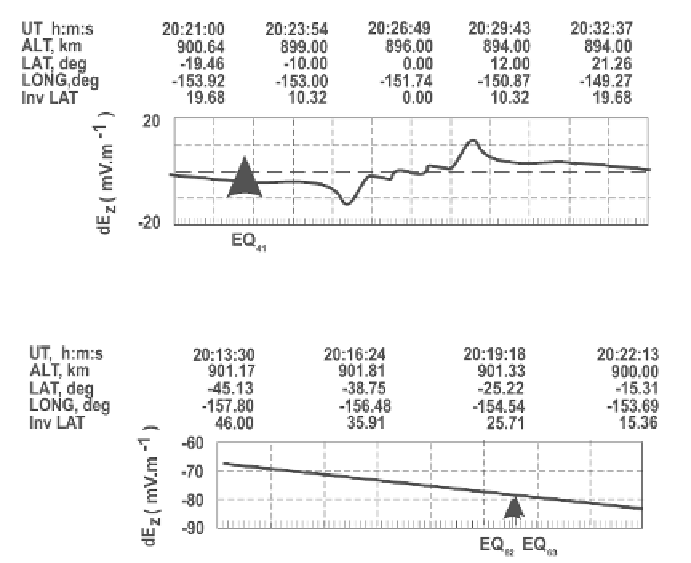Geoscience Reference
In-Depth Information
determination of the infl uence of the events EQ
2,3
and EQ
7
(near to EQ
26
). Any distur-
bances from pair EQ
27
,
28
are not observed (∆λ > 20°) as well. It should be also noted
that these measurements are made in a quiet day (K
p
= 3), so the observed anomalies
are not caused by a solar-terrestrial disturbance. The satellite passes (orbit 527) at ∆λ
= 19.61°E (Figure 2a) about 300 hr after the major earthquake EQ
41.
The disturbances in the
E
z
component of the quasi-static electric fi eld: the fi rst
one to the north of the earthquake epicenters (projection over the equipotent magnetic
fi eld lines in the near-equatorial ionosphere at satellite altitude) and second one--in
the magnetic conjugate region of about 12 mV/m for EQ
41
are shown in Figure 2d.
The major earthquake event is followed by two strong aftershocks EQ
42,43
the next
2 hr, also by a series of other ones in subsequent days (EQ
44,45,47,48,50,51,52,64,68
) and two
strong aftershocks EQ
53,54
(see Table 1). Thus major and great earthquakes occur fre-
quently in this region. It is unlikely, that these post effects could provoke an increase
in
Ez
component of about 12 mV/m. Any post effects (Figure 2e) from EQ
62,63
cannot
be observed (λ > 20
◦
). It should be noted that the above mentioned data are taken in a
very quiet day (K
p
= 1).
Figure 2d.
Disturbances in
E
z
component of the quasi-static field, orbit 527.
Figure 2e.
Vertical component
E
z
of the quasi-static field, orbit 527.
Indonesian Region
The Indonesian region is one of the most seismically active zones on the Earth. It is an
island-arc structure of about 17,000 islands. The islands of South-East Indonesia lie at

















